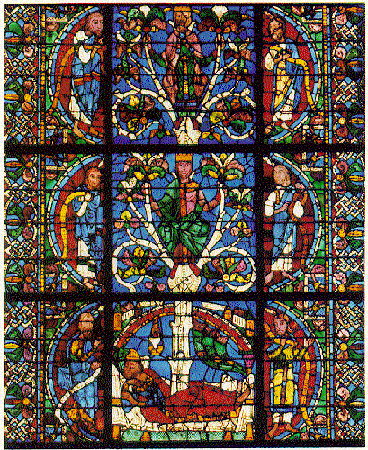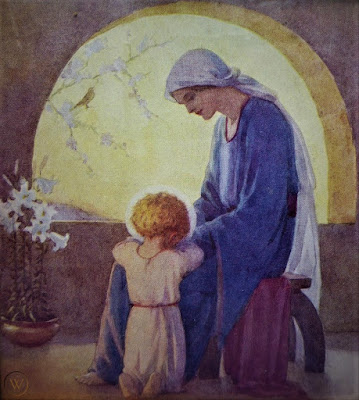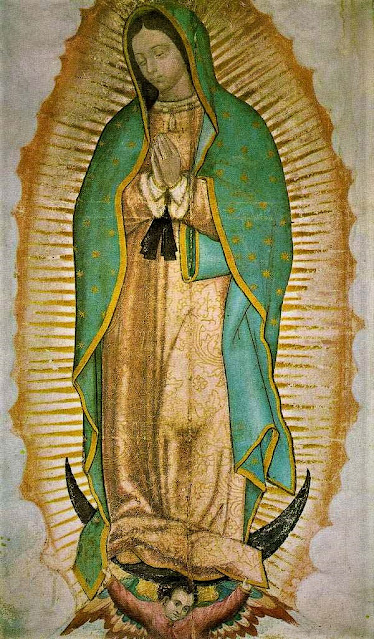To all of that, Mary said “yes.” And it is in her “yes” to God that we find a treasury of truth – truths around which we form our devotion – because these truths about Mary speak impressively about her divine Son. So what are they?
First, the Church teaches us that Mary was immaculately conceived. At the instant of Mary’s conception in the womb of her mother, St. Anne, she was, by the special grace of God, protected from the stain of original sin. Why would God do that? He did it because of the great destiny which was hers – that of being the Mother of God. It was her flesh which would give flesh to Jesus; it was her body which would be His tabernacle for nine months; therefore, it would be beyond possibility that the Mother of God should be stained with the sin of Adam, since God can endure no sin. This was taught implicitly and explicitly from the earliest days of the Church, and was confirmed and solemnly proclaimed by Pope Pius IX in 1854, when he stated infallibly, “The most holy Virgin Mary was, in the first moment of her conception, by a unique gift of grace and privilege of Almighty God, in view of the merits of Jesus Christ the Redeemer of mankind, preserved free from all stain of original sin.”
Second, the Church teaches us that Mary was impeccable. In other words, she committed no personal sin, and she was free from every moral imperfection. Certainly, she lived a human life. She was wife and mother, so had work to do and was subject to pain and tiredness; but she, like her son Jesus Christ, had nothing in her which led her to act against the perfect moral law of God. This formal teaching of the Church is deduced from the words of the archangel Gabriel, when he addressed her as being “full of grace,” since moral guilt could not be reconciled with being filled completely with God’s grace. Once again, this teaching is defined because of Mary’s relationship with her Son, and not through simple merit of her own. She did not sin because of a special grace and privilege given to her by God, because He had chosen her to bear the Incarnate Word.
Third, the Church teaches us that Mary was perpetually a virgin. Three states of virginity are professed in this teaching: Mary conceived her Son without a human Father; she gave birth to Jesus without violating her virginity; and she remained a virgin after our Lord was born, for the rest of her life. The virginal conception is contained in all the ancient creeds, which speak of “Jesus Christ… who was conceived by the Holy Spirit of the Virgin Mary...” The biblical basis of this, of course, is the prophecy of Isaiah (“A virgin shall conceive and bear a son...”), and it is confirmed in St. Matthew’s Gospel, which quotes this directly from the prophecy of Isaiah. All the early Church Fathers confirm this teaching, and it was verified by the fifth general council of the Church, held at Constantinople in the year 553, where Mary was confirmed as being “perpetually virgin.” Certainly, the ancient theologians did not go into the physical details, but they speak in modest analogies, such as the “emergence of Christ from the sealed tomb,” his “going through closed doors,” the “penetration of light through glass,” the “going out of human thought from the mind.” The Church also teaches us that she remained a virgin after Christ was born. Her marriage to Joseph was not consummated physically, and so she bore no other children. From the fourth century on, such sayings as that of St. Augustine became common: “A virgin conceived, a virgin gave birth, and a virgin remained.”
All these truths about Mary go beyond her, to her Son Jesus Christ. All of them are true because of the one great truth of history: that Almighty God took human flesh upon Himself, and was born of this special woman, a virgin, chosen by God Himself, a virgin prepared for this task through her immaculate conception, a virgin preserved for this task through her impeccability, a virgin honoured for this task through her perpetual virginity, as a constant witness to the fact that it was her pure flesh which was given to the Incarnate Word. These truths are not simply esoteric theological statements. They are truths which impact history. They are truths which prepared for that ultimate moment of history when God entered personally into time and space.
It was at that time that Caesar Augustus, the master of the world, determined to issue an order for a census of the world which was ruled by Rome. To every outpost, to every corner, the order went out: every Roman subject must be enrolled in his own city. It certainly was not in the mind of Caesar Augustus that his imperial order was a part of God’s great plan that the Saviour of the world should be born of the chosen Virgin Mary in a little-known place called Bethlehem. But this order of Caesar Augustus – perhaps thought of by him only incidentally, and then ordered casually – meant that countless lives were interrupted as people gathered the necessary supplies for their various journeys. So it was that Joseph and Mary, visited by angels and touched by God, were traveling in eternity at the order of an earthly ruler. And because of that, how things were to change! In a dirty stable, Pure Love was born. The “Living Bread come down from heaven” was laid where animals had eaten. The ancestors of Joseph and Mary, the Jews, had worshipped the golden calf, and now the ox and the ass were bowing down before their God.
As Mary fulfilled the plan of God by conceiving and giving birth to Jesus Christ, so His passion began. He was born in a borrowed stable; He was buried in a borrowed tomb. The swaddling clothes which Mary wrapped around him when he was born looked forward to the grave-clothes which she would help to wrap around His lifeless body some thirty-three years later. The wooden manger in which His mother had laid him foreshadowed the wooden Cross from which she would receive His body into her arms.
And so in Christ, heaven came to earth, and it came through the Blessed Virgin Mother. God’s glory was announced to shepherds and to kings. And they came, as men and women have been coming ever since, to worship the Word Made Flesh.

























